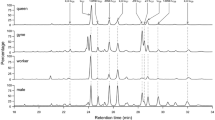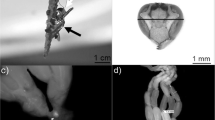Abstract
Nestmate recognition in eusocial insects has received a lot of attention in the last decades. Recognition in subsocial species, in contrast, has been ignored almost completely and consequently, and little is known about proximate mechanisms of recognition in subsocial systems. We studied one subsocial species, the biparental brood caring burying beetle Nicrophorus vespilloides, an interesting model organism for studies of recognition because of its ability to discriminate between breeding partners and conspecific competitors. Recognition appears to be based on a chemical cue closely linked to the breeding status of individuals. Breeding and non-breeding beetles consistently differ in their relative proportions of polyunsaturated cuticular hydrocarbons. To investigate the function of these polyenes in the burying beetles’ recognition system, we quantified their concentration on the cuticle during the early state of a breeding attempt and tested the response of breeding beetles in corresponding behavioural experiments. We observed a rapid increase in the proportion of polyunsaturated hydrocarbons of both males and females after they were provided with a carcass suitable for reproduction. Furthermore, we found that the relative amount of polyenes on an individual’s surface was closely correlated with its chance of being accepted as breeding partner. Our results support the idea that polyunsaturated hydrocarbons are involved in breeding partner recognition in N. vespilloides, functioning as a signal that conveys information about the individual’s breeding status. Breeding females have greater amount of polyenes than breeding males, and females ingest more carrion during the first days on the carcass, which supports our hypothesis that precursors for the respective polyenes are derived from ingested carrion.


Similar content being viewed by others
References
Ayasse M, Marlovits T, Tengo J, Taghizadeh T, Francke W (1995) Are there pheromonal dominance signals in the bumblebee Bombus hypnorum L (Hymenoptera, Apidae). Apidologie 26:163–180
Bagnéres AG, Killian A, Clement JL, Lange C (1991) Interspecific recognition among termites of the genus Reticulitermes—evidence for a role for the cuticular hydrocarbons. J Chem Ecol 17:2397–2420
Choe JC, Crespi BJ (1997) Social behavior in insects and arachnids. Cambridge University Press, Cambridge
Costa JT (2006) The other insect societies. Belknap Press of Harvard University Press, Cambridge, Massachusetts
Cuvillier-Hot V, Cobb M, Malosse C, Peeters C (2001) Sex, age and ovarian activity affect cuticular hydrocarbons in Diacamma ceylonense, a queenless ant. J Insect Physiol 47:485–493
Cuvillier-Hot V, Lenoir A, Crewe R, Malosse C, Peeters C (2004) Fertility signalling and reproductive skew in queenless ants. Anim Behav 68:1209–1219
Cuvillier-Hot V, Renault V, Peeters C (2005) Rapid modification in the olfactory signal of ants following a change in reproductive status. Naturwissenschaften 92:73–77
De Biseau JC, Passera L, Daloze D, Aron S (2004) Ovarian activity correlates with extreme changes in cuticular hydrocarbon profile in the highly polygynous ant, Linepithema humile. J Insect Physiol 50:585–593
Dietemann V, Liebig J, Hölldobler B, Peeters C (2005) Changes in the cuticular hydrocarbons of incipient reproductives correlate with triggering of worker policing in the bulldog ant Myrmecia gulosa. Behav Ecol Sociobiol 58:486–496
Eggert A-K, Müller JK (1997) Biparental care and social evolution in burying beetles: lessons from the larder. In: Choe JC, Crespi BJ (eds) The evolution of social behavior in insects and arachnids. Cambridge University Press, Cambridge, pp 216–236
Eickwort GC (1981) Presocial insects. In: Hermann HR (ed) Social insects, vol. 2. Acadamic, New York, pp 199–280
Hartmann A, D’Ettorre P, Jones GR, Heinze J (2005) Fertility signaling—the proximate mechanism of worker policing in a clonal ant. Naturwissenschaften 92:282–286
Howard RW, Blomquist GJ (2005) Ecological, behavioral, and biochemical aspects of insect hydrocarbons. Annu Rev Entomol 50:371–393
Kaib M, Jmhasly P, Wilfert L, Durka W, Franke S, Francke W, Leuthold RH, Brandl R (2004) Cuticular hydrocarbons and aggression in the termite Macrotermes subhyalinus. J Chem Ecol 30:365–385
Lahav S, Soroker V, Hefetz A, Vander Meer RK (1999) Direct behavioral evidence for hydrocarbons as ant recognition discriminators. Naturwissenschaften 86:246–249
Liebig J, Peeters C, Oldham NJ, Markstadter C, Hölldobler B (2000) Are variations in cuticular hydrocarbons of queens and workers a reliable signal of fertility in the ant Harpegnathos saltator? Proc Natl Acad Sci USA 97:4124–4131
Montag W, Klenk E, Hayes H, Holman RT (1957) The eicosapolyenoic acids occurring in the glycerophosphatides of beef liver. J Biol Chem 227:53–60
Müller JK (1987) Replacement of a lost clutch—a strategy for optimal resource utilization in Necrophorus vespilloides (Coleoptera, Silphidae). Ethology 76:74–80
Müller JK, Eggert AK (1990) Time-dependent shifts between infanticidal and parental behavior in female burying beetles: a mechanism of indirect mother–offspring recognition. Behav Ecol Sociobiol 27:11–16
Müller JK, Eggert A-K, Elsner T (2003) Nestmate recognition in burying beetles: The “breeder’s badge” as a cue used by females to distinguish their mates from male intruders. Behav Ecol 14:212–220
Panaitof SC, Scott MP, Borst DW (2004) Plasticity in juvenile hormone in male burying beetles during breeding: physiological consequences of the loss of a mate. J Insect Physiol 50:715–724
Peeters C, Monnin T, Malosse C (1999) Cuticular hydrocarbons correlated with reproductive status in a queenless ant. Proc R Soc Lond B Biol Sci 266:1323–1327
Pukowski E (1933) Ökologische Untersuchungen an Necrophorus F. Z Morphol Ökol Tiere 27:518–586
Rantala MJ, Vainikka A, Kortet R (2003) The role of juvenile hormone in immune function and pheromone production trade-offs: a test of the immunocompetence handicap principle. Proc R Soc Lond B Biol Sci 270:2257–2261
Reeve HK (1989) The evolution of conspecific acceptance thresholds. Am Nat 133:407–435
Scott MP (1990) Brood guarding and the evolution of male parental care in burying beetles. Behav Ecol Sociobiol 26:31–40
Scott MP, Trumbo ST, Neese PA, Bailey WD, Roe RM (2001) Changes in biosynthesis and degradation of juvenile hormone during breeding by burying beetles: a reproductive or social role? J Insect Physiol 47:295–302
Singer TL (1998) Roles of hydrocarbons in the recognition systems of insects. Am Zool 38:394–405
Sledge MF, Trinca I, Massolo A, Boscaro F, Turillazzi S (2004) Variation in cuticular hydrocarbon signatures, hormonal correlates and establishment of reproductive dominance in a polistine wasp. J Insect Physiol 50:73–83
Steiger S, Peschke K, Francke W, Müller JK (2007) The smell of parents: breeding status influences cuticular hydrocarbon pattern in the burying beetle Nicrophorus vespilloides. Proc R Soc Lond B 274:2211–2220
Stoppie P, Briers T, Huybrechts R, Deloof A (1981) Molting hormone, juvenile-hormone and the ultrastructure of the fat-body of adult Sarcophaga bullata (Diptera). Cell Tissue Res 221:233–244
Thomas ML, Parry LJ, Allan RA, Elgar MA (1999) Geographic affinity, cuticular hydrocarbons and colony recognition in the Australian meat ant Iridomyrmex purpureus. Naturwissenschaften 86:87–92
Tillman JA, Seybold SJ, Jurenka RA, Blomquist GJ (1999) Insect pheromones—an overview of biosynthesis and endocrine regulation. Insect Biochem Mol Biol 29:481–514
Trumbo ST (1990a) Interference competition among burying beetles (Silphidae, Nicrophorus). Ecol Entomol 15:347–355
Trumbo ST (1990b) Reproductive benefits of infanticide in a biparental burying beetle Nicrophorus orbicollis. Behav Ecol Sociobiol 27:269–273
Trumbo ST (1997) Juvenile hormone-mediated reproduction in burying beetles: from behavior to physiology. Arch Insect Biochem Physiol 35:479–490
Trumbo ST (2006) Infanticide, sexual selection and task specialization in a biparental burying beetle. Anim Behav 72:1159–1167
Trumbo ST, Valletta RC (2007) The costs of confronting infanticidal intruders in a burying beetle. Ethology 113:386–393
Trumbo ST, Wilson DS (1993) Brood discrimination, nest mate discrimination, and determinants of social behavior in facultatively quasisocial beetles (Nicrophorus spp.). Behav Ecol 4:332–339
Trumbo ST, Borst DW, Robinson GE (1995) Rapid elevation of juvenile hormone titer during behavioral assessment of the breeding resource by the burying beetle, Nicophorus orbicollis. J Insect Physiol 41:535–543
Wagner D, Tissot M, Cuevas W, Gordon DM (2000) Harvester ants utilize cuticular hydrocarbons in nestmate recognition. J Chem Ecol 26:2245–2257
Wilson EO (1971) The insect societies. Harvard University Press, Cambridge
Wyatt T (2003) Pheromones and animal behaviour: communication by smell and taste. Cambridge University Press, Cambridge
Acknowledgements
We thank Anne-Katrin Eggert for very helpful comments on the manuscript, Volker Nehring for assistance with R and Wolf Haberer and Thomas Schmitt for technical assistance. All experiments complied with the German laws. The study was supported by a Ph.D. grant from the German National Academic Foundation to S. S. and by a grant from the Deutsche Forschungsgemeinsachaft to J.K.M (Mu 1175/3-1).
Author information
Authors and Affiliations
Corresponding author
Additional information
Communicated by P. Moore
Rights and permissions
About this article
Cite this article
Steiger, S., Peschke, K. & Müller, J.K. Correlated changes in breeding status and polyunsaturated cuticular hydrocarbons: the chemical basis of nestmate recognition in the burying beetle Nicrophorus vespilloides?. Behav Ecol Sociobiol 62, 1053–1060 (2008). https://doi.org/10.1007/s00265-007-0532-x
Received:
Revised:
Accepted:
Published:
Issue Date:
DOI: https://doi.org/10.1007/s00265-007-0532-x




